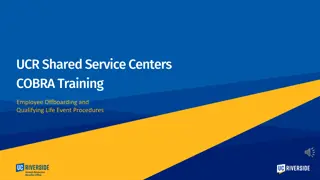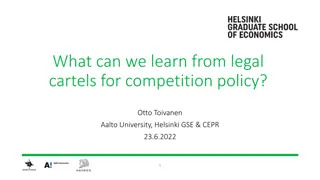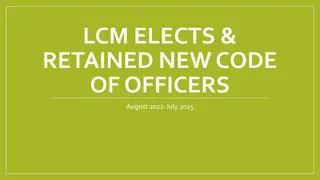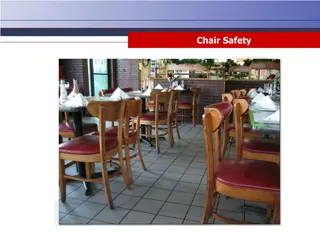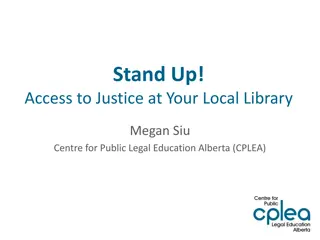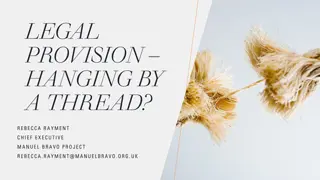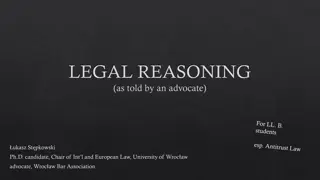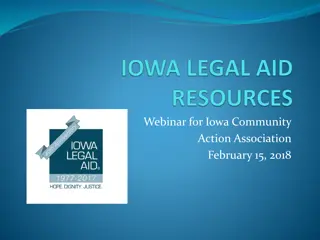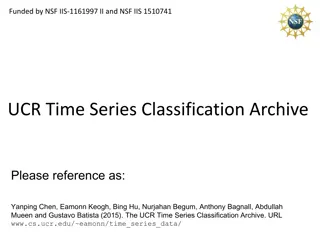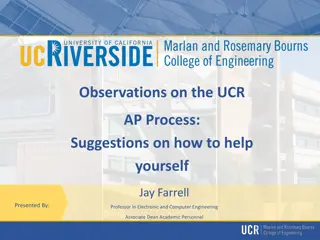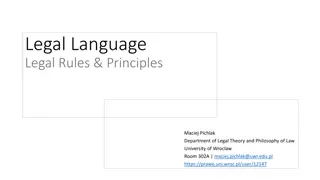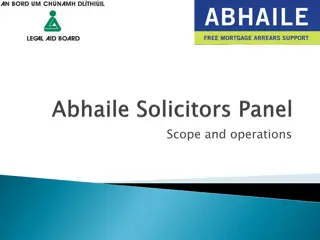New Chair Training: Legal and Policy Insights at UCR
Explore key insights from the New Chair Training session at UCR led by David Bergquist, Chief Campus Counsel. Topics covered include the role of Campus Counsel, resources available, issue spotting, top issues faced by faculty, students, and administrators over the past five years, and important administrative discussions.
Download Presentation

Please find below an Image/Link to download the presentation.
The content on the website is provided AS IS for your information and personal use only. It may not be sold, licensed, or shared on other websites without obtaining consent from the author. Download presentation by click this link. If you encounter any issues during the download, it is possible that the publisher has removed the file from their server.
E N D
Presentation Transcript
New Chair Training: Legal/Policy Presented at UCR by David Bergquist, Chief Campus Counsel October 2, 2020 1
Role of Campus Counsel Duty to the Regents (the Institution) Dual Report to Chancellor and to General Counsel Clients include Upper Level Administrators of UCR (including Associate Vice Chancellor Lam and her Equity Advisors) Office is a resource funded by the Chancellor to the Schools and Departments within UCR and OP 2
Do Not Try to Go it Alone Resources (other than Diversity and Inclusion Office): Locally Designated Official (LDO) Student Special Services Human Resources/Affirmative Action/Academic Personnel Campus Counsel (Office of Legal Affairs) Ombudsperson Title IX/CARE Advocate Vice Provost of Administrative Resolution (VPAR) Critical Student Incident Team UCR Police 3
Learn to ISSUE SPOT You don t have to act as counsel You don t have to act as ombuds You don t have to act as HR rep, Affirmative Action Office, Chief Compliance Officer, VPAR or Chief Bottle Washer 4
Top Issues for Past 5 Years Faculty: Hiring/Promotion/Retention/Diversity Freedom Of Speech/Academic Freedom/Bullying Title IX/CANRA Disability Accommodation Discipline Hostile Work Environment Discrimination Research Misconduct Conflict of Commitment 5
Top Issues Students: Disability Accommodation Free Speech/DACA/Immigration Title IX/CANRA Understanding when they are acting as a student versus an employee (CBA) FERPA/HIPAA Hostile Learning/Work Environment Posting/Recording IP of Faculty Mental Health/Behavior Issues 6
Top Issues for Discussion Administrative: Public Records Act (PRA) and Information Practices Act (IPA) requests Disability Accommodation Delegations of Authority Stop the Clock Whistleblower Claims (LDO) Title IX/VAWA 7
Guiding Principles Equal Access Diversification of faculty/students/staff Fair Treatment Abide by Policies Consistent Process Good Faith Efforts 9
Employment Laws and Policies Anti-discrimination laws (a subsection of employment law) are designed to protect prospective employees and employees from being treated unfairly based upon specific characteristics and were enacted to ensure equality in employment. Supervisors and managers (including with help from Equity Advisors) play an integral role in ensuring compliance with employment laws by setting the appropriate tone and fairly and consistently applying: Recruiting Practices Performance Management (progressive discipline, appraisals and day-to-day supervision) Application of Personnel Policies and Practices, including the APM 10
Federal Employment Laws Title VII of The Civil Rights Act of 1964 ( Title VII ) prohibits discrimination in employment based upon race, color, sex, religion, and national origin. Age Discrimination in Employment of 1963 ( ADEA ) prohibits discrimination against people age 40 years or older. Americans with Disabilities Act of 1990 ( ADA ) prohibits discrimination against qualified individuals with disabilities. Family Medical Leave Act in part, prohibits employment actions based upon the taking of protected family medical leave. Equal Pay Act of 1963 prohibits wage discrimination based upon gender. Lily Ledbetter Fair Pay Act discrimination in violation of Title VII, ADEA and ADA (compensation) will accrue every time an employee receives a paycheck that is discriminatory. Redefined the statute of limitations. Uniform Services Employment and Reemployment Rights Act ( USERRA ) - prohibits discrimination in employment based upon current or former military service. Genetic Information Non-Disclosure Act ( GINA )- prohibits employment decisions based on genetic information (including family medical history). 11
CaliforniaEmployment Laws California s Fair Employment and Housing Act ( FEHA ) prohibits discrimination or harassment on the basis of protected characteristics. FEHA provides broader protections for employees than the Federal Statutes and most legal actions are brought under state law as opposed to federal laws (Title VII, ADEA, ADA etc). 12
University Anti-Discrimination Policies A number of University Policies prohibit discrimination in employment based upon personal characteristics. Non-Discrimination Policy and Affirmative Action Policy Re Academic and Staff Employment (PPSM 12 and 14; APM-035) prohibits discrimination on the basis of race, color, sex, sexual orientation, gender identity, physical/mental disability, marital status, Religion, Citizenship, genetic information, physical/medical condition, pregnancy, uniformed services, etc. PPSM 14 (Affirmative Action) PPSM 20 (Recruitment) PPSM 21 (Appointment) Principles of Community Sexual Harassment & Sexual Violence Policy APM 13
Theories of Employment Discrimination Disparate Impact a facially neutral employment practice that has a disproportionate impact on a protected group. Largely a statistical analysis and unintentional 1. Disparate Treatment an individual of a protected group is shown to have been singled out and treated less favorably than others similarly situated on the basis of an impermissible criterion. Most common type of discrimination claim and is usually case specific and intentional 2. 14
Discrimination vs. Harassment Discrimination - is an adverse employment action based upon a protected characteristic, as opposed to a legitimate work-related reasons. For example: Hiring Promotion Work Assignments Pay Determinations Failure to accommodate Separation Harassment (a type of discrimination) is workplace behavior by any person based on a protected characteristic that unreasonably interferes with work performance or creates an intimidating, hostile or offensive work environment. 15
Discrimination vs. Harassment HOSTILE WORK ENVIRONMENT Is a type of discrimination/harassment. Anti-discrimination/Anti-harassment laws don t require civil or tasteful behavior. But forbids discriminatory workplace behaviors that are objectively offensive so as to negatively affect the conditions of employment. The severity of the conduct is judged by a reasonable person considering all the circumstances involved in the situation. Whether the conduct is severe or pervasive; supervisors should never tolerate conduct or behavior that is unwelcome, offensive and directed at an employee because of any protected status! 16
The Universitys Obligations The law provides that once an employer knows or should have known of unlawful discriminatory or harassing conduct, the employer must take prompt and effective remedial action. The remedy used must be reasonably calculated to end the harassment and must offer more than a temporary solution or result. This may require corrective action or discipline. 17
Harassment Workplace Harassment is more than sexual harassment but is actually harassment based on all protected characteristics and is prohibited by law. All claims of Sexual Harassment or Violence must be promptly reported to the Title IX Compliance Officer or other appropriate official. New UC and Campus Policies regarding Bullying and Harassing Behaviors 18
Anti-Bullying Policy New Campus Policy Building on APM and Regents Policy 1111 (Statement of Ethical Values and Standards of Ethical Conduct) Conduct of an employer or employee in the workplace, with malice, that a reasonable person would find hostile, offensive, and unrelated to an employer s legitimate business interests. 19
Anti-Bullying Policy Abusive conduct may include repeated infliction of verbal abuse, such as the use of derogatory remarks, insults, and epithets, verbal or physical conduct that a reasonable person would find threatening, intimidating, or humiliating, or the gratuitous sabotage or undermining of a person s work performance. A single act shall not constitute abusive conduct, unless especially severe and egregious. 20
Anti-bullying Training Requirement California Government Code Section 12950.1 Effective January 1, 2015 Requires employers with 50 or more employees to include the prevention of "abusive conduct" as a component of training that is already required in the area of sexual harassment. For purposes of this section, abusive conduct means conduct of an employer or employee in the workplace, with malice, that a reasonable person would find hostile, offensive, and unrelated to an employer s legitimate business interests. Abusive conduct may include repeated infliction of verbal abuse, such as the use of derogatory remarks, insults, and epithets, verbal or physical conduct that a reasonable person would find threatening, intimidating, or humiliating, or the gratuitous sabotage or undermining of a person s work performance. A single act shall not constitute abusive conduct, unless especially severe and egregious. 21
Anti-bullying Training Requirement Already included in UC online and live training sessions. Does it create a new cause of action for abusive conduct in the workplace? No. While it may not good business practices, there is no law in California that makes workplace bullying or abusive conduct as defined in GC 12950.1 illegal. The policy reason behind not making such conduct illegal is that it would be difficult to determine what conduct is simply discipline, counseling, and day-to- day management actions versus actions taken with malice by a manager. Making such conduct actionable under the law would, in effect, make the court system the final decision maker in resolving normal day-to-day workplace disputes, which could stress the already overwhelmed court system. Could this amendment eventually lead to a law making abusive conduct illegal? Potentially. Even though there is no legal cause of action for abusive conduct as defined in the new law, this type of legislation could be amended to make this conduct illegal in the future. 22
Equity Advisors are Key Players in Preventing Discrimination and Bullying/Harassment Be aware of unacceptable behaviors. Be a role model and teach by example. Make sure that faculty, students and staff understand the range of behaviors that will not be tolerated. Do not allow sexist, bigoted, or sexual remarks. Do not participate in sending or forwarding email jokes, cartoons, or articles that could be considered offensive. Make it a practice to consistently and promptly address discriminatory or harassing remarks or behaviors. Identify areas which might disclose vulnerabilities in UC practices 23
Newer APM 210 Section The University of California is committed to excellence and equity in every facet of its mission. Contributions in all areas of faculty achievement that promote equal opportunity and diversity should be given due recognition in the academic personnel process, and they should be evaluated and credited in the same way as other faculty achievements. For faculty in this title series, these contributions to diversity and equal opportunity are most likely to be focused on teaching and learning and can take a variety of forms including efforts to advance equitable access to education, public service that addresses the needs of California s diverse population, or teaching that is particularly sensitive to diverse populations. Mentoring and advising of students and faculty members particularly from underrepresented and underserved populations should be given due recognition in the teaching or service categories of the academic personnel process 24
APPOINTMENT AND PROMOTION APM - 210 Review and Appraisal Committees APPENDIX A Statement on Professional Ethics The Statement: III. As colleagues, professors have obligations that derive from common membership in the community of scholars. Professors do not discriminate against or harass colleagues. They respect and defend the free inquiry of associates. In the exchange of criticism and ideas professors show due respect for the opinions of others 25
Duty To Investigate State and Federal law require an employer to promptly and fairly investigate a charge of discrimination or harassment. California Law: Requires an employer to take all reasonable steps to prevent discrimination. Some California courts have held that a duty to prevent discrimination includes the duty to investigate allegations of discrimination or harassment. Duty to investigate simply means that supervisor/managers must have all relevant facts before taking corrective action (fact finding investigation coordinated with appropriate campus office). The investigation must be adequate to objectively determine central facts. 26
When should Chairs investigate? Within 24 hours Within 3 Business Days Within One Week None of the above 27
Duty To Investigate Adequate investigation leads to good decision-making, but also helps as an affirmative defense if a lawsuit is eventually filed. It will show that the University acted in good faith when it learned of the situation. For faculty, Chairs and others are first responders in discrimination and harassment complaints. They must learn enough about the facts to determine whether a more extensive investigation is needed. If so, immediately contact HR and/or Title IX Compliance Officer for assistance. The Chair will contact the VPAR (Faculty) or HR (Staff) for guidance prior to conducting any investigation. 28
Hypothetical 1 Chair receives email from faculty member asserting unfair treatment, offensive conduct/communication, or violation of law/policy and retaliation. Example: Dr. B raised an issue in our discussion about Candidate X; after I informed him I was offended, he devalued my contribution to department discussions and I believe he voted against my promotion. I have audiotape I surreptitiously recorded which backs up my claims. 29
Employment Best Practices WHAT DO YOU DO IF YOU LEARN THAT DISCRIMINATORYOR HARASSING BEHAVIOR MAY BE HAPPENING? Meet with the complaining faculty member immediately, if requested to understand the allegations. If the faculty member alleges sexual harassment or sexual violence, relay the complaint immediately to the Title IX Compliance Office If the faculty member alleges other discriminatory or harassing behavior, contact the VPAR or Campus Counsel. Once action is taken, follow up with that person, depending on the severity of the action, to see if the behavior has stopped. Document the follow-up conversations. (CONFIDENTIALITY) Don t consider the complaint as minor or insignificant until you know the facts. Complaints of discrimination or harassment must be investigated to the extent reasonably possible, even when the victim is reluctant or declines to cooperate. Complaints of discrimination or harassment must be looked into even if the Chair believes the immediate problem is already resolved! 1. 2. 3. 4. 5. DON T HESITATE TO GET HELP CAMPUS RESOURCES ! 6. 30
Employment Best Practices DISABILITYMANAGEMENT 31
DM Best Practices DISABILITY MANAGEMENT Disability Discrimination is the most frequent alleged discrimination claim at the UC. Every Campus has Resident Experts on Disability Management Demetrius Patrick, Disability Management Coordinator Laura Riley, Student Special Services Call them early and often. It can be complicated. Expect to be unsure what to do and get help! The Interactive Process is the Key! 32
Employment Best Practices DISABILITY DEFINED: A person is considered disabled in California if he/she: Has a physical or mental impairment that limits one or more of the major life activities; Has a record of such an impairment; Is regarded as having such an impairment (perceived); Is regarded or treated by the employer as having some condition that has no present disabling effect, but may become a physical disability; or Has any health impairment that requires special education or related services. 33
Employment Best Practices Disability puts employees in a protected category along with sexual orientation, race, religion, etc. There is a similar protection for pregnant employees. Job accommodations for disabled employees are mandated by: Federal Law: Americans With Disabilities Act (ADA) State Law: Fair Employment & Housing Act (FEHA) UC Policy: PPSM 81 & APM 711- Reasonable Accommodation and Collective Bargaining Agreement 34
EmploymentBest Practices WHATISTHE INTERACTIVE PROCESS (IP)? It is the heart of the Accommodation process. Ongoing dialogue between the employer/employee department/student regarding how the person is limited in his ability to perform the essential functions of his position or access to an education and what, if any, reasonable accommodations could enable him to perform those essential functions. If no reasonable accommodations could enable her to perform the essential functions of the current position, the IP then includes an exploration of whether there are alternative positions that are open for which the employee is qualified. 35
EmploymentBest Practices THE INTERACTIVEPROCESS (IP) Three Basic Steps to the IP: Step 1: Identify the essential functions of the job Step 2: Determine the employee s limitations Step 3: Explore whether employee s limitations can be reasonably accommodated. DO NOT ASK ABOUT DIAGNOSIS OR FOR HEALTH PROFESSIONAL LETTER 36
Hypothetical 2 After midterm, student identifies to her professor that she had a health issue that impacted her grade. Faculty member asks her diagnosis and indicates he may be willing to change her grade if she provides a letter from her doctor. She refuses and ends up failing the course. She confides to the faculty member that she is only 17, and that she was sexually assaulted by her R.A., which caused her to fail her course. 37
Whistleblower Claims EXAMPLESOF PROTECTED DISCLOSURES Faculty member filed a whistleblower claim accusing the Department Head of misusing Medicare Funds. Faculty member filed a grievance or disciplinary complaint. Employee used one or all of the complaint processes provided by federal or state law or University policy. An employee exercised a right guaranteed by Federal law, State law, University Policy or Labor Agreement. An employee complained about discrimination or the discriminatory treatment of others. 38
Whistleblowers WHATIS RETALIATION? Retaliation occurs when a supervisor or employer engages in an activity which, has an adverse action, as it discourages an employee from exercising a right protected by law. Important Note: A claim of retaliation might be sustained even if the employee s underlying report is unsubstantiated. 39
Whistleblower Best Practices ELEMENTSOFA RETALIATION CLAIM Employee made a protected disclosure or engaged in a protected act; Employer took adverse action against employee; and Causal connection Employer took adverse action b/c Employee engaged in a legally protected activity. 1. 2. 3. 40
Whistleblower Best Practices EXAMPLESOF ADVERSE ACTIONS Demotion/Discipline (including a counseling memo) Layoff/Termination Transfer Mediocre Performance Review/ Merit Review Failure to Promote Change in a complainant s work assignments Avoidance of the complainant Sarcasm toward the complainant Declining to invite the complainant to an office party, lunch or business meeting A series of smaller actions that subtly change the terms and conditions of an employee s job over time. 41
Whistleblower Best Practices THE CAUSAL CONNECTION BECAUSEOF The claimant must provide some evidence that there is a connection between the protected disclosure or act and the adverse action. If the claimant provides enough information to establish a connection, the University must show the non-retaliatory reasons for the action. Key point: Any adverse action taken against any employee should be motivated by only legitimate, documented business reasons. 42
Between a rock and a hard place Scenario: Employee Bjorn Lyer, filed a complaint with the LDO alleging that a faculty member had done something he believed was an improper governmental activity (IGA). An investigation was done (under the Whistleblower Policy), which resulted in a finding that the faculty member had not done what was alleged and even if they had, it would not have been an IGA. Faculty member feels relieved and vindicated but also annoyed that a complaint was ever filed. 43
Between a rock and a hard place Bjorn was never a model employee, although he was routinely rated Meets Expectations on his performance evaluations and his supervisor hoped he would improve. Since filing the complaint, Bjorn s performance has completely gone downhill. Dozens of his projects are overdue, the ones he has turned in are filled with errors, and he is never at the office. Just when Dept is about to put him on a Performance Improvement Plan, the faculty member happens to overhear him crowing to a coworker that he s been totally blowing off work but knows he is untouchable because he blew the whistle. What can you do? 44
Employment Best Practices COMPLAINT PROCESSES 45
Employment Best Practices COMPLAINT PROCESSES Any University Employee has the right to redress workplace grievances in one or more of the following ways: UC Informal Complaint Resolution Processes UC Formal Complaint Resolution Processes External Complaint Processes Formal Complaint Processes University employees can lodge complaints re: violations of University Personnel Policies or Labor Agreements through a variety of mechanisms Academic Personnel/VPAR Labor Agreements PPSM Whistleblower and Whistleblower Retaliation46
Employment/Instructional Best Practices EXTERNAL COMPLAINT PROCESSES The U.S. Equal Employment Opportunity Commission (EEOC). The U.S. Department of Labor (DOL). California Department of Fair Employment and Housing (DFEH) Office of Federal Contract Compliance Program (OFCCP). Department of Education, Office for Civil Rights (OCR) 47
Internal Grievance & Complaint Resources (Academic Personnel) UC Systemwide Senate Bylaws 334-337 (UCR Appendix 5) Non-Senate Academic Appointees APM 140 Whistleblower Policy and Whistleblower Protection Policy UCR Academic Senate Bylaws Collective Bargaining Agreements The Office of Faculty and Staff Affirmative Action, Office of the Ombuds, Title IX/Sexual Harassment, Auditing and Accounting, and the Vice Provost of Administrative Resolution. UCR Campus Policy Number 650-17 48
Equal Employment & Affirmative Action Compliance 49
Executive Order 11246 Prohibitsfederal contractors and subcontractors who have contracts of $10,000 in one year from discriminating in employment decisions on the basis of race, color, religion, sex, sexual orientation, gender identity or national origin, disability and veteran status. Requires federal contractors to take affirmative steps to ensure that equal opportunity is provided in all aspects of their employment. Must develop a written Affirmative Action Plan (AAP). Department of Labor s Office of Federal Contractor Compliance Programs (OFCCP) is tasked with enforcement. 50



